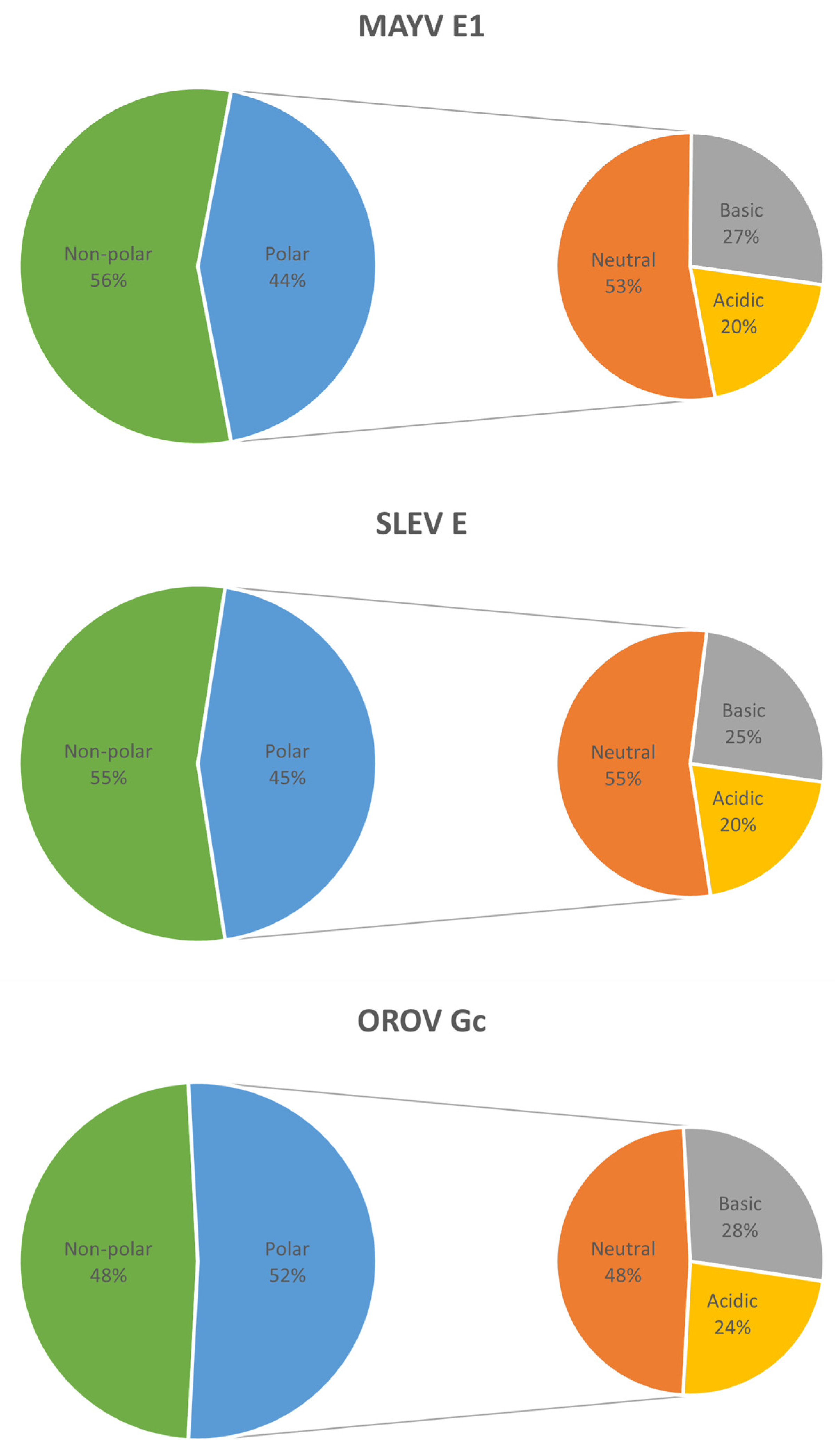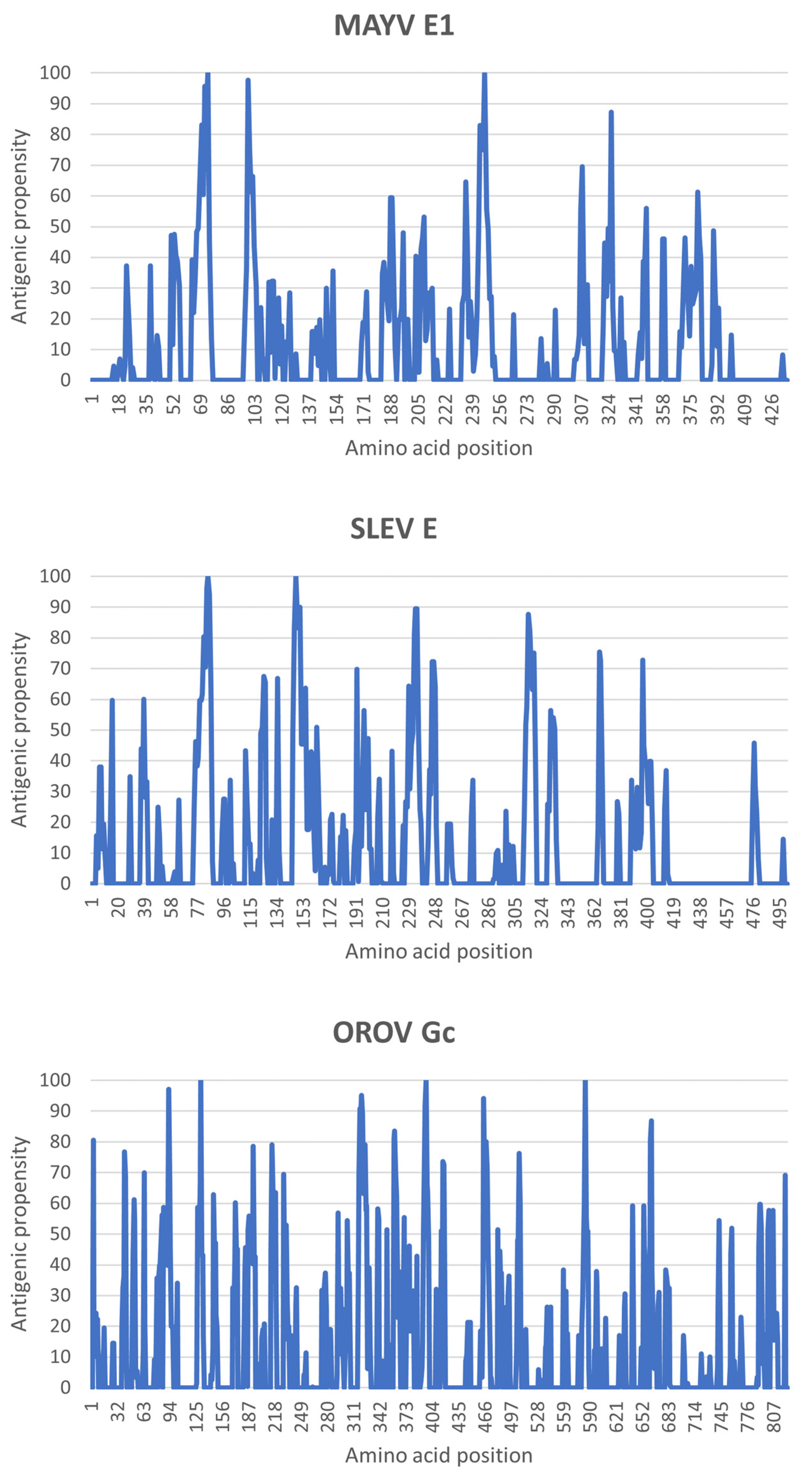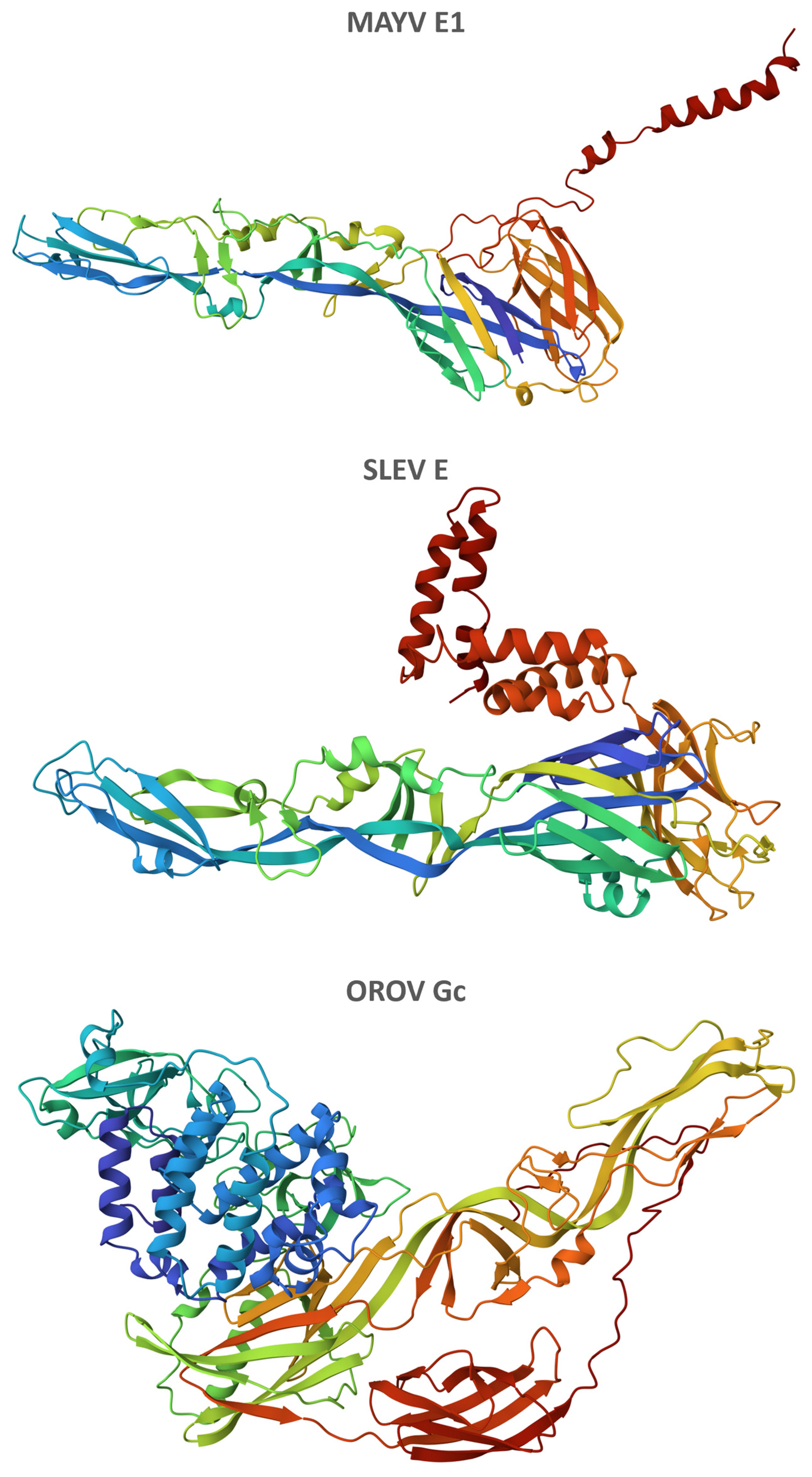In Silico Physicochemical Characterization of Fusion Proteins from Emerging Amazonian Arboviruses
Abstract
1. Introduction
2. Materials and Methods
2.1. Collection of Amino Acid Sequences
2.2. Multiple Sequence Alignment
2.3. Estimation of Residual Properties
2.4. Prediction of Secondary Structures
2.5. Identification of Potential Post-Translational Modifications
2.6. Recognition of Antigenic Propensities
2.7. Modeling and Refinement of Three-Dimensional Structures
3. Results
3.1. Sequence Identity between MAYV, SLEV, and OROV Fusion Proteins
3.2. Residual Properties of MAYV, SLEV, and OROV Fusion Proteins
3.3. Secondary Structures in MAYV, SLEV, and OROV Fusion Proteins
3.4. Potential Post-Translational Modifications in MAYV, SLEV, and OROV Fusion Proteins
3.5. Antigenic Propensities of MAYV, SLEV, and OROV Fusion Proteins
3.6. Three-Dimensional Structures of MAYV, SLEV, and OROV Fusion Proteins
4. Discussion
5. Conclusions
Supplementary Materials
Author Contributions
Funding
Institutional Review Board Statement
Informed Consent Statement
Data Availability Statement
Acknowledgments
Conflicts of Interest
References
- Young, P.R. Arboviruses: A Family on the Move. In Dengue and Zika: Control and Antiviral Treatment Strategies; Springer: Berlin/Heidelberg, 2018; Volume 1062, pp. 1–10. [Google Scholar] [CrossRef]
- Weaver, S.C.; Reisen, W.K. Present and future arboviral threats. Antivir. Res. 2010, 85, 328–345. [Google Scholar] [CrossRef] [PubMed]
- Swei, A.; Couper, L.I.; Coffey, L.L.; Kapan, D.; Bennett, S. Patterns, Drivers, and Challenges of Vector-Borne Disease Emergence. Vector-Borne Zoonotic Dis. 2020, 20, 159–170. [Google Scholar] [CrossRef] [PubMed]
- Harrison, S.C. Viral membrane fusion. Virology 2015, 479–480, 498–507. [Google Scholar] [CrossRef] [PubMed]
- Podbilewicz, B. Virus and Cell Fusion Mechanisms. Annu. Rev. Cell Dev. Biol. 2014, 30, 111–139. [Google Scholar] [CrossRef] [PubMed]
- White, J.M.; Delos, S.E.; Brecher, M.; Schornberg, K. Structures and Mechanisms of Viral Membrane Fusion Proteins: Multiple Variations on a Common Theme. Crit. Rev. Biochem. Mol. Biol. 2008, 43, 189–219. [Google Scholar] [CrossRef] [PubMed]
- Lorenz, C.; Azevedo, T.S.; Virginio, F.; Aguiar, B.S.; Chiaravalloti-Neto, F.; Suesdek, L. Impact of environmental factors on neglected emerging arboviral diseases. PLoS Neglected Trop. Dis. 2017, 11, e0005959. [Google Scholar] [CrossRef] [PubMed]
- Modis, Y. Relating structure to evolution in class II viral membrane fusion proteins. Curr. Opin. Virol. 2014, 5, 34–41. [Google Scholar] [CrossRef] [PubMed]
- Sayers, E.W.; Bolton, E.; Brister, J.R.; Canese, K.; Chan, J.; Comeau, D.C.; Connor, R.; Funk, K.; Kelly, C.; Kim, S.; et al. Database resources of the national center for biotechnology information. Nucleic Acids Res. 2021, 50, D20–D26. [Google Scholar] [CrossRef] [PubMed]
- Sievers, F.; Wilm, A.; Dineen, D.; Gibson, T.J.; Karplus, K.; Li, W.; Lopez, R.; McWilliam, H.; Remmert, M.; Söding, J.; et al. Fast, scalable generation of high-quality protein multiple sequence alignments using Clustal Omega. Mol. Syst. Biol. 2011, 7, 539. [Google Scholar] [CrossRef] [PubMed]
- Rice, P.; Longden, I.; Bleasby, A. EMBOSS: The European Molecular Biology Open Software Suite. Trends Genet. 2000, 16, 276–277. [Google Scholar] [CrossRef] [PubMed]
- Combet, C.; Blanchet, C.; Geourjon, C.; Deléage, G. NPS@: Network Protein Sequence Analysis. Trends Biochem. Sci. 2000, 25, 147–150. [Google Scholar] [CrossRef] [PubMed]
- Kelley, L.A.; Mezulis, S.; Yates, C.M.; Wass, M.N.; Sternberg, M.J.E. The Phyre2 web portal for protein modeling, prediction and analysis. Nat. Protoc. 2015, 10, 845–858. [Google Scholar] [CrossRef] [PubMed]
- Bhattacharya, D.; Cheng, J. 3Drefine: Consistent protein structure refinement by optimizing hydrogen bonding network and atomic-level energy minimization. Proteins Struct. Funct. Bioinform. 2012, 81, 119–131. [Google Scholar] [CrossRef] [PubMed]
- Zhang, J.; Zhang, Y. A Novel Side-Chain Orientation Dependent Potential Derived from Random-Walk Reference State for Protein Fold Selection and Structure Prediction. PLoS ONE 2010, 5, e15386. [Google Scholar] [CrossRef] [PubMed]
- Kielian, M. Class II virus membrane fusion proteins. Virology 2006, 344, 38–47. [Google Scholar] [CrossRef] [PubMed]
- Vaney, M.-C.; Rey, F.A. Class II enveloped viruses. Cell. Microbiol. 2011, 13, 1451–1459. [Google Scholar] [CrossRef] [PubMed]
- Kumar, R.; Mehta, D.; Mishra, N.; Nayak, D.; Sunil, S. Role of Host-Mediated Post-Translational Modifications (PTMs) in RNA Virus Pathogenesis. Int. J. Mol. Sci. 2021, 22, 323. [Google Scholar] [CrossRef] [PubMed]
- Lopes-Ribeiro, Á.; Araujo, F.P.; Oliveira, P.d.M.; Teixeira, L.d.A.; Ferreira, G.M.; Lourenço, A.A.; Dias, L.C.C.; Teixeira, C.W.; Retes, H.M.; Lopes, N.; et al. In silico and in vitro arboviral MHC class I-restricted-epitope signatures reveal immunodominance and poor overlapping patterns. Front. Immunol. 2022, 13, 1035515. [Google Scholar] [CrossRef] [PubMed]
- Guardado-Calvo, P.; Rey, F.A. The Viral Class II Membrane Fusion Machinery: Divergent Evolution from an Ancestral Heterodimer. Viruses 2021, 13, 2368. [Google Scholar] [CrossRef] [PubMed]






Disclaimer/Publisher’s Note: The statements, opinions and data contained in all publications are solely those of the individual author(s) and contributor(s) and not of MDPI and/or the editor(s). MDPI and/or the editor(s) disclaim responsibility for any injury to people or property resulting from any ideas, methods, instructions or products referred to in the content. |
© 2023 by the authors. Licensee MDPI, Basel, Switzerland. This article is an open access article distributed under the terms and conditions of the Creative Commons Attribution (CC BY) license (https://creativecommons.org/licenses/by/4.0/).
Share and Cite
Leal, C.S.; Carvalho, C.A.M. In Silico Physicochemical Characterization of Fusion Proteins from Emerging Amazonian Arboviruses. Life 2023, 13, 1687. https://doi.org/10.3390/life13081687
Leal CS, Carvalho CAM. In Silico Physicochemical Characterization of Fusion Proteins from Emerging Amazonian Arboviruses. Life. 2023; 13(8):1687. https://doi.org/10.3390/life13081687
Chicago/Turabian StyleLeal, Crislaine S., and Carlos Alberto M. Carvalho. 2023. "In Silico Physicochemical Characterization of Fusion Proteins from Emerging Amazonian Arboviruses" Life 13, no. 8: 1687. https://doi.org/10.3390/life13081687
APA StyleLeal, C. S., & Carvalho, C. A. M. (2023). In Silico Physicochemical Characterization of Fusion Proteins from Emerging Amazonian Arboviruses. Life, 13(8), 1687. https://doi.org/10.3390/life13081687





